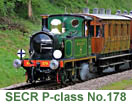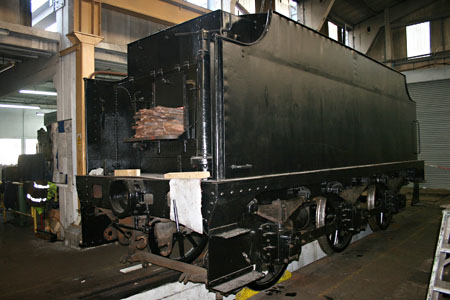

|


|

|
|
Locomotives - Operational Locos - Locos under overhaul - Locos on static display - Locos formerly based on the Bluebell Loco Roster - Loco Stock List - Loco Works News - Join the Loco Dept 

Loco Workshop Working Group
|
| Working parties are now held on the 1st and 3rd
Sundays of each month, and the team have made a start on the overhaul
of SR Q-class No.541.
Any Bluebell Railway members interested in lending a hand can e-mail for more information or to let us know that you will be coming along. We meet at 9am - 9.30am outside the loco works. You are welcome to attend whatever hours you can, as any help will be appreciated. Keep an eye on this web page, or e-mail for details of future working dates. See you there. Rob Faulkner, David Pratt and Duncan Bourne |
This
project:
Previous Loco Workshop Working Group Overhauls:    |
|
|
Update - August 2013

Despite a lack of updates, the group has still be making regular visits to Sheffield Park to assist with the overhaul of Q-Class 541. Unfortunately due to the well documented issues with the running fleet, the overhaul has had to take a back seat whilst the workshop staff and volunteers concentrated efforts on repairs. With both C-Class 592 and U-Class 1638 requiring attention, the frames for 541 were moved out of the works at the end of 2012, allowing these locos to enter the works for repairs.
The photograph on the right shows the chassis for 541 in the works again during August 2013.
During the Autumn, the Wheelsets for 541 had been sent away for tyre turning at the South Devon Railway and on their return, the group set about cleaning these up and repainting. This work took several visits and required good weather as the wheelsets were located outside in the yard. However by late spring, all three wheelsets has been primed, undercoated and received their first topcoat. The final topcoats will be done prior to the loco being rewheeled.
During the visits when the weather was not suitable to work on the wheels outside, the group has been working on cleaning up various components within the works, in preparation of the loco being rewheeled. This has included cleaning several years of grime from the motion of the locomotive and repainting some of the smaller components such as brake rods, hangers etc. In addition to this the group has also been assisting workshop staff when needed on the repairs to 592 and 1638.
The photograph on the left shows the wheelsets following their arrival back from turning in December 2012.
During the last few months and with the weather having improved, the group has turned their attentions to cleaning up the top half of the frames. This has included rubbing back the paintwork on the cabsides, which had developed a crazed patten from years of being exposed to the elements. The paintwork was stripped back to bare metal with primer being applied before being repainted in black undercoat. Also the inside of the cab has been cleaned up and the first coats of paint are now being applied here as well.
The workshop staff having been working on the boiler as time permits and this has recently been turned upside down, to allow work to be carried out on the outer firebox, with new section of platework being added to the bottom half (a similar repair to what the group did with P-Class 178).
With work on 592 now complete and the boiler for S15 841 back in the frames, the frames and wheels for 541 have re-entered the works. Over the next few weeks, it is planned to machine the axleboxes in preparation for re-wheeling the locomotive. Once re-wheeled the group can then make a start on refitting the motion and various sections of pipework.
Finally as you may have seen, the group are trying to raise funds for a clock to be erected in memory of Phil Stoneman who sadly passed away last year. We are approximately 50% of the way to reaching our target. It is planned to erect the clock at the end of the new above workshop facility. If you would like to donate towards this, then you can do so via our Just Giving page or by cheque (which avoids the JustGiving fees, thus raising more money for the project) via the donation form available as a PDF file.
With a planned return to steam for 2014, the group will have a varity of jobs to complete over the coming months. Should you wish to get involved, and help get 541 back into steam for 2013, then send us an e-mail.
The photographs below show the boiler for 541 being overhauled, the nearly completed tender on the washout pit, and Nick and Alan working on polishing the journals in preparation for re-wheeling the locomotive.



Update - July 2012

It is hard to believe that it is already July. Since the report in April, the overhaul of the tender has been completed and attention has moved onto the overhaul of the loco itself. At the beginning of June, the group were informed that Phil Stoneman, one of our founder members of the group, had sadly passed away following a short illness. Phil was well liked and will be sorely missed by the group and others from around the railway.
The boiler was lifted in July, using the workshop's own cranes and as a result saving on the expense of hiring in a mobile crane to perform this task. The boiler has since been detubed and the smokebox removed from the front tubeplate. Whilst some of the group have spent the last couple of visits wirebrushing the boiler and painting it with a protective coat of paint, others have been removing the remains of rivets from the outside of the front tubeplate where the smokebox and boiler were joined.
The photograph on the right handside, shows the boiler following being cleaned up and painted, waiting to enter the works.
With the loco chassis now in the works, attention during the last few visits has turned to getting the frames ready for lifting from the wheelsets. This has included removing any motion that is attached to the wheelsets, brake blocks and hangers etc. Only once these tasks were complete, could the frames be separated from the wheelsets. This was completed just before our last visit. With the wheelsets removed, the team spent the day, removing the axleboxes, so they can be cleaned and remetalled prior to reassembly. The wheels need cleaning and most likely turning, before they can be reunited with the frames.
The photograph on the left shows the wheelsets following removal from the frames.
With the wheelsets removed, it has allowed us to start cleaning the inside of the frames, prior to repainting. As you can probably imagine, after several years service on the railway and the spending the last 19 years as a static exhibit, some of this grime can be a bit resistant to removal. However with a bit of elbow grease, we are getting there and it won't be long before fresh coats of paint can be applied.The final job for our last visit, was to empty the sandboxes. The sanders had not worked during 541's last ticket and as a result some of the sandboxes still contained genuine British Railways sand in them. With this removed and any loose rust removed, the sanders can be overhauled, ready for service during it's next ticket.
With the overhaul on the loco and the boiler now under way, the group will have a varity of jobs to complete over the next few months. Should you wish to get involved, and help get 541 back into steam for 2013, then send us an e-mail.
Update - April 2012

Since our last report, the group have been busy on completing the tender, so space can be freed up in the works for the loco overhaul to begin. This has involved the team cleaning up and then painting the various components that need to be refitted to the tender, once it has been re-wheeled. The group has done a sterling job on these and they are now sitting ready for the time they can be put back onto the tender.
In addition to this, the group has also been assisting in rubbing down the paintwork, in preparation for a repaint to begin. This again has involved many hours of rubbing down paintwork, painting it in primer (where required) and then undercoat, then rubbing it back down and painting again, so the new layers can be built up for a good finish to be applied at the end.

The group has expanded with a number of new faces since the last report. As a result we are in the lucky position where we can carry out some additional tasks during our fortnightly visits.
Therefore some of the team have been tirelessly working away on cleaning up the boiler cladding and cab roof. This is following a similar process to the tender, of having to be sanded down, primed where required and then painted in a couple of layers of undercoat before the top coat can be applied. Whilst the cladding will not be needed for a few months yet, it is one of those jobs we can complete now whilst we have some spare hands, meaning there is less of a delay when it comes to reassembly of the loco, later in the year.
On Sunday 15th April the team were presented with the news that the tender was finally ready to be re-wheeled. This process took most of the morning, but by lunchtime the tender was finally sitting on its wheelsets again. The afternoon was spent reassembling the springs to the frames, which the team managed to complete by the end of the day. Now the wheel-sets are back in the frames, the various brake gear components can start to be reassembled over the next few weeks, before the tender can be moved out of the works and replaced by the boiler of 541.
Should you wish to get involved, and learn how steam engines work in the process, then send us an e-mail.
Update - December 2011
With repairs to the tender almost complete and the wheelsets being away for turning, the group continued during December to prepare the boiler for lifting.
Our visit during the first Sunday in December saw the team concentrating on preparing the cladding for removal. This involved removing any bolts securing the cladding in place and putting temporary straps around the barrel to ensure it remained secure. Also handrails and any associated components that would prevent the cladding from being removed were also loosened, so they could be quickly removed when required. Whilst this should have been a relatively easy job, it took us the majority of the day to complete due to various complications such as having to visit Horsted Keynes to get some straps and also the cladding being welded together.
Two weeks later the team were down again (along with festive hats!) to remove the cladding. 541 and its tender were dragged out of the running shed after the locos had left the yard for the morning. It was then all hands to deck, to remove the cab roof and cladding before the first locos returned in the late afternoon. For once everything seemed to go to plan and by early afternoon we had removed the cab roof and cladding from the boiler barrel. In addition we had also removed all the old lagging. As light was starting to fade, the group used muscle power to push the loco back into the shed, before 323 "Bluebell" pushed the tender back into the shed.
Our next few visits will see us cleaning up the boiler barrel, cladding and starting to reassemble components onto the tender. Should you wish to get involved, and learn how steam engines work in the process, then send us an e-mail.




Update - November 2011
Since the last update, much has happened in the last couple of months. The tender had all the brake gear removed, and was then lifted off its wheels (as shown by Lewis Nodes picture on the right of the page) before all being cleaned and painted. The wheels are now in the yard, waiting to be sent away for turning, when Camelot's wheels return from the South Devon Railway. The rest of the tender was mounted onto a wagon and pushed inside the works. All the parts are being carefully labelled and stored ready for reassembly, once the wheels have returned from being reprofiled.
In the space of a few weeks, an enormous amount of work has been done, much of it by the loco works staff. The leaks in the tank bottom have been patched, and the piece removed from the coal space welded back in. The handrails around the rear have also had new platework made and welded, as the old metal had wasted away and it was becoming unsafe. New stainless steel water valves have been made and fitted. The buckled running plate above the rear buffer beam has been removed and a new piece welded in. Apart from a few minor jobs, rubbing down, painting and re-wheeling, the tender is pretty much complete.
Attention has turned to the loco itself, although this is difficult until it enters the works. To prepare for a boiler lift, all the pipework and fittings have been removed from the cab and boiler sides. Removing the concrete from the top of the cylinders is a nasty job, but everybody is having a go and it is slowly coming out. This will reveal the bolts holding the smokebox on.Work has also started on trying to remove the main steam pipes from the smokebox, although they seem reluctant to move. All the jobs will allow us to lift the boiler in the near future.
A couple of new volunteers have joined since the last update, which is very welcome. As always, if you'd like to help get 541 back together for next year, and learn how steam engines work in the process, then send us an e-mail.



Update - August 2011
Since the last update, the team have continued to dismantle the tender, for its overhaul. The brakegear has now all been removed and Shaun has gone over the components with a pressure washer, to remove several years of oil and dirt that had accumulated on them. These have now been labeled up and are almost ready for a coat of paint, before being stored until they are required during the reassembly stage.
We have also made a start of removing the edging strip that surrounds the top of the tender at the back end. The platework is corroded in several locations and the edging therefore needs to be removed so that the wasted material can be ground back, to allow for new material to be welded on and then the edging strip will be riveted back on. In addition to this, the team have worked on splitting the tender from the loco, which has now been completed.
Phil has been working on cutting an access point from the coal space, to allow for some areas of the tank to be welded, where leaks have been noticed following filling up the tender to wash out any remaining debris from within the tank. This work will ensure the tender is water tight. Once this has been completed, the section cut out will be welded back into the coal space.
Last visit saw the team, concentrating their efforts on removing the brake cylinders. This needed to be done to allow for them to be overhauled, but more importantly, because it is planned to lift the tender off its wheels in the next few weeks, so they can be sent away for reprofiling.
If you wish to come along and lend a hand, then you can e-mail for more information or to let us know that you will be coming along.


Q-Class 541 Overhaul Begins
Following the completion of 323 back in March, the team have been working on creation some space for storing the various components that will need to come off 541 during its overhaul. This took several weeks to complete as it also involved assembling some new racking to increase capacity of the storage area. This work was completed in early June, meaning work could then start on 541's overhaul.
Before we could start the overhaul, the running shed at Sheffield Park, needed to be reorganised, mainly due to 541 being at the far end of the shed and several locomotives being in the way. On Sunday 19th June, Baxter was employed to shunt the various locos in the shed and move 541 to the other end of the running shed. This was a move that took most of the day, but by the time the first locos were arriving back on shed, the move had been completed.
With 541 now accessible, the team met up on Sunday 3rd July, to start work on 541. Initially the team will be working on overhauling the tender of 541, before hopefully moving onto the loco at some point next year. The group spent the day working on disconnecting the tender from the loco, whilst Nick did a brilliant job, spending most of his day, cleaning out all the rust from within the tender tank.
On Sunday 17th July, the team returned to continue on dismantling the tender. Nick finished off cleaning out the tender tank, before joining the rest of us in dismantling the brakegear from the tender. This task took most of the day, but by the end of it, we had removed all the brake blocks and most of the brake rods that run under the chassis, from the tender.
The group will next be down on Sunday 7th August, when if all goes to plan we will have a number of cleaning jobs to do, in conjunction with continuing to dismantle various components from the tender. If you wish to come along and lend a hand, then you can e-mail for more information or to let us know that you will be coming along.
Go to the web page for this loco
or return to the Archive of Loco Works News


Return to BRPS Home Page, to the Timetable or to Special Events
Locos Intro - Operational Locos - Locos under overhaul - Locos on static display - Locos formerly based on the Bluebell
Loco Roster - Loco Stock List - Loco Works News - Join the Loco Dept
Visitor Info. - Museum - Trust - Catering - Contacts - What's New - Projects - Locos - Carriages & Wagons - Signals - History - Other - Links - Search - FAQ
Why not become a BRPS Member? - Get more involved as a Volunteer
Updated 28 August 2013 by Richard Salmon with thanks to Rob Faulkner
Reformatted 17 April 2022
© Copyright BRPS. Privacy Policy






